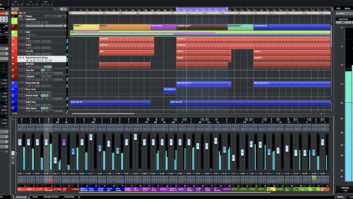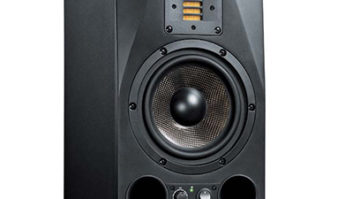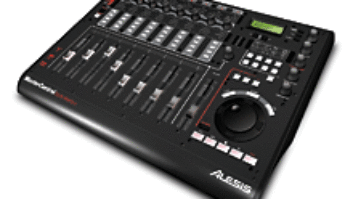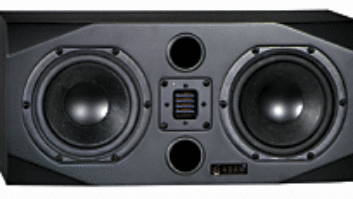The look of the Model 24 is reminiscent of TASCAM’s Portastudio of yesteryear, but the functionality is light years beyond what those cassette-based multitrack recorder/mixers could do. The Model 24 is an extremely versatile piece of gear that can function as a live or studio mixer, multitrack recorder and audio interface.
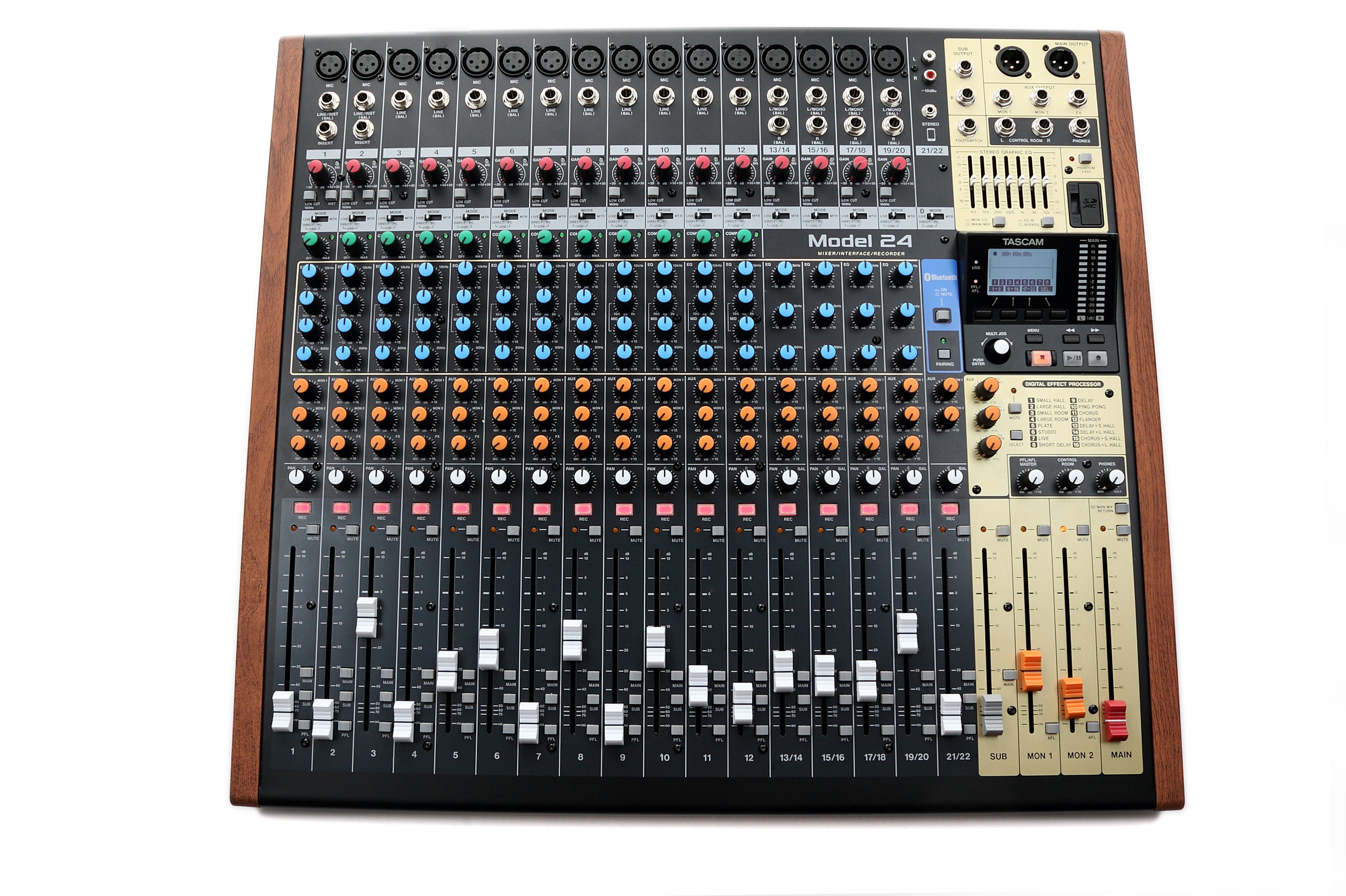
At a shade under 23 inches wide and about 20 inches deep, the Model 24 is compact without feeling cramped. It offers 22 physical channels—12 mono and 5 stereo—and each can be independently set to one of three input sources: Live, for signals coming through the analog inputs; USB, for signals coming from the computer; and MTR, for playback from the built-in, SD-card-based, multitrack recorder. The recorder offers two additional channels, 23-24, for handling mixdowns.
To the right of the channel faders is the master section, which consists of the main fader, a fader for each of the two monitor sends, and one for the Sub output.
The mono channels all have XLR and ¼-inch balanced inputs for mic and line-level signals, respectively. The ¼-inch jacks for Channels 1 and 2 also accept high-impedance sources and are equipped with Insert jacks. The Inserts only affect channels that are set to Live mode.
Four of the five stereo channels are equipped with a pair of balanced ¼-inch line inputs. The last one, Channel 21-22, offers unbalanced RCA jacks and a 3.5mm jack. It also features a Bluetooth input, allowing you to pair a phone, tablet or laptop to play music through the board. When using the Model 24 in a live-sound application, it makes it easy to incorporate break music.
All 22 channels also have switchable Low-Cut Filters that roll off below 100 Hz, as well as input Gain knobs with status LEDs that light green for signal present and red for overload.
Master bus metering is provided by two nice-sized LED-ladder displays. A small (roughly 1.75×1-inch) backlit LCD display lets you see individual channel levels, as well as a variety of screens relating to the multitrack recorder and system preference settings. You can navigate through the LCD with a jog shuttle knob and five selection buttons.
The Way In
Mono channels 1 through 12 are the most fully featured on the Model 24. Each is equipped with a one-knob Compressor with an adjacent indicator LED that lights when gain reduction is applied. Like the Inserts, the Compressors only work when the input-select for the track is set to Live.
Each of the 16 mono channels has an identical EQ section. The high and low bands are fixed-frequency shelving EQs with a boost/cut knob. The midrange band is semi-parametric, featuring both frequency select (100 Hz to 8 kHz) and boost/cut knobs. On the stereo channels, all three bands are fixed; there’s no adjustable midrange frequency.
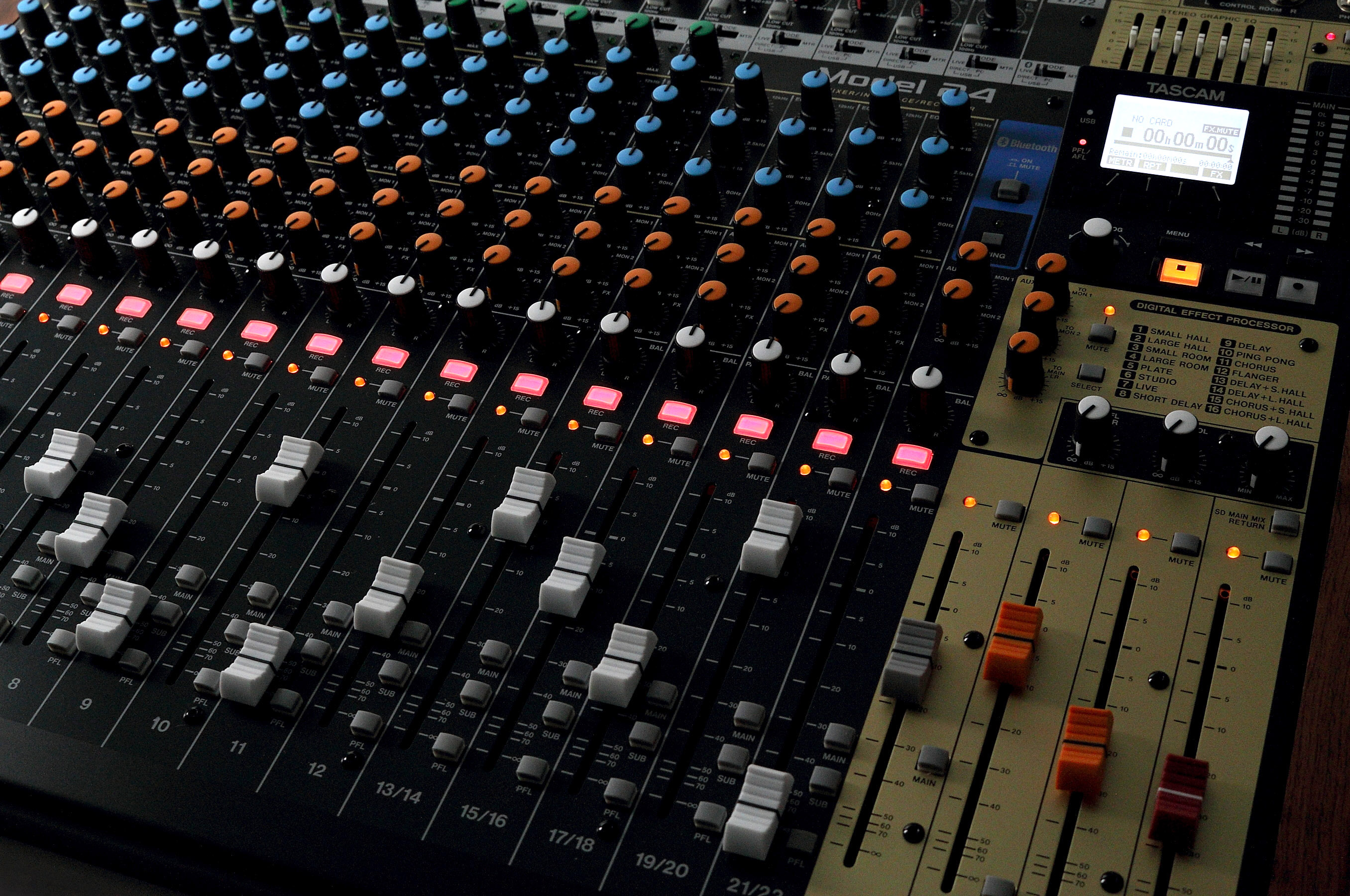
The EQ frequency settings for the low- and high-shelving bands are quite musical, and I was surprised by how effective the EQ section is, in general. Between the three bands and the Low-Cut filter, you can really sculpt a sound.
Continuing down the channel strip, you get a knob for each of the two monitor sends and an effects return, which controls the return of the built-in effects (more on those in a bit).
All of the channels also feature Pan knobs, 100mm faders, record-enable buttons for the built-in multitrack and Mute buttons. There are no solo buttons.
The Model 24 is equipped with phantom power, but, disappointingly, it’s controlled by a single global switch for all the mic inputs. Although I don’t expect individual phantom switches for each channel in this price range, it would have been useful to be able to switch it on for groups of channels, or even have a couple of mic inputs that don’t get phantom at all. That way, if you have any mics, such as certain ribbon mics that you don’t want to send phantom power to, you have that option.
Finally, at the bottom of each channel are routing switches for sending signal to the Main mix, the Sub out and PFL. The latter routes the audio to the PFL/AFL bus, which cuts off the main output and lets you listen to individual channels pre-fader or after—if you press one of the AFL buttons located on the Monitor 1 and 2 faders, to the monitor mix.
On stereo channel 21-22 is the Bluetooth input. It has two controls, a Pairing button and a handy Mute/On switch.
The master section includes faders for four different mixes: Sub mix, two monitor mixes and the Main mix. You can route the various channels to the Sub and Main mixes using track-based buttons. You use the Aux 1 and 2 knobs for creating monitor mixes.
At the top right of the unit are corresponding outputs, including XLR jacks for the Main outs and ¼-inch TRS stereo pairs for the Sub and Aux (monitor) outputs. You also get PFL/AFL Master, Control Room Outputs and a Phones output.
Another critical feature in is a 7-band analog graphic EQ that can be placed in the Monitor or Main signal path, or bypassed.
Effects and Everything
The Model 24 sports a built-digital effects processor into which you can send signals from the individual channels using their FX knobs. Only one effect can be active at a time, but more than half of the 16 effects choices are combinations of two.
Effects include a selection of reverbs, delays, a chorus and a flanger. You also get several combo effects that combine reverb with delay and reverb with chorus. The reverbs are pretty good, but overall the effects are not particularly memorable.
Without adjustable parameters, and with only one effect type active at a time, the built-in effects are mainly useful for live mixing or for monitoring when recording. The effects don’t print to the recorder when used on a live source, but they will if you mix down to channels 23-24 on the built-in recorder.
22 Is Nice
The onboard multitrack recorder (22 tracks plus a 2-track stereo mix) is one of the features that makes the Model 24 so appealing. The unit comes sans SD card, so you need to supply one. It can handle standard SD cards from 512 MB to 2 GB, SDHC cards from 4 GB to 32 GB and SDXC cards from 64 GB to 128 GB.
I put in a 32 GB SDHC card, and the unit showed about 24 hours of available recording time. That would be over an hour per track if you were using all 22, which is pretty impressive. And if you use larger SDXC cards, you can get quite a bit more track time.
Compared to recording to a hard drive, you’ll find that the card-based recording is slower, in that when you take the unit out of record, you have to wait several seconds (longer for longer tracks) while it finishes writing the data to the card.
You can choose between 16- and 24-bit resolution and 44.1 and 48 kHz sampling rates. The unit records to Wave files and can import both standard Wave and BWF (Broadcast Wave).
The recorder offers overdub, locator, pre-roll and punch-in features. It even has a footswitch jack for triggering punch-ins if you’re working by yourself. The footswitch (TASCAM RC-1F or equivalent) is not included.
With the Model 24’s small LCD, file management is a bit tedious. When you create a song, it is automatically given a long numerical name, and changing that requires multiple entries of letters with the jog shuttle wheel, which is pretty slow-going.
Despite some inconveniences, the recording quality is pristine, and the multitrack capability is hugely convenient. I would guess that the most popular application for the built-in recorder will be to record live shows or rehearsals in which the Model 24 is used as a live mixer. For an artist or band, that capability would be a real luxury and isn’t something you’d expect out of your live mixing console.
What makes the onboard recorder even more valuable is that you can easily transfer files from the SD card to your computer and back.
When you put the Model 24 into Storage mode, it shows up as a drive on your computer. You can then copy files from its MTR (multitrack recorder) folder to your computer. Also, anything you put into its Music folder can then be imported into a song on the Model 24.
I was disappointed to discover that the channel 23-24 mixdowns, which get made automatically from the master bus, showed up on my computer as separate, non-interleaved files. After importing them into my computer, I had to combine them in my DAW or audio editor before I could play them. That’s something I hope TASCAM will remedy.
At least on my Mac, the MTR folder also contained a lot of temporary files that created visual clutter in the directory.
The Go-Between
The third primary function of the Model 24 is as an audio interface. Once connected by USB, it will be recognized as an interface by your DAW as long as you’ve installed its drivers.
It gives you some pretty useful features as an interface, especially if you’re planning on recording ensembles of any type. One of those is 16 input channels with mic and line inputs. Having two monitor mixes would also be handy in group-tracking situations.
What’s more, you can use the mixing features, such as the compressor and EQ on input, when recording to your DAW, giving you additional control.
You can even mix through the Model 24’s channel strips if you want. Every input shows up in your DAW’s I/O choices, so you can route tracks directly from the outputs of your DAW’s mixer to the inputs of the Model 24 and mix in analog (while still using all the digital features of your DAW’s mixer).
Model 24’s interface supports 16- and 24-bit resolutions and 44.1 and 48 kHz sampling rates, same as for the SD card recorder.
24 and Versatile
I used the Model 24 for a couple of months while researching this review. After I got over the novelty of having an outboard mixer in my studio for the first time in many years, I put it through its paces and was quite pleased overall. The mic preamps are clean and quiet, and, considering you get 16 of them, it makes the Model 24 quite a value on a cost-per-channel basis.
Although limited in adjustability, the channel EQs sound quite good, and I had kind of forgotten how much easier it is to quickly dial in a nice-sounding tone with an analog EQ, as opposed to a plug-in.
With its clean sound quality, mono front end, built-in multitrack and interface capabilities and plentiful I/O—not to mention its affordability—the Model 24 is an impressive product. Sure, there are some things I’d like to see changed—such as the phantom-power switching and the lack of solo buttons, but overall it does an excellent job of integrating both analog and digital features into a coherent unit that serves a multitude of functions.
PRODUCT SUMMARY
Company: TASCAM
Product: Model 24
Website: Tascam.com
Price: $999.99
Pros: Versatile functionality for live and studio; built-in 22-track recorder with stereo mixdown; capable audio interface with 16 mic preamps; easy file transfer between computer and Model 24; analog front end; 100mm faders; two monitor mixes; graphic EQ for main or monitor mixes; additional Sub output; compressor for each mono input channel.
Cons: No solo buttons; small LCD display; export of mixdown from card results in non-interleaved dual files; track naming and housekeeping can be tedious; compressors only work on Live input mode; global phantom-power switching only.
